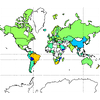For related work, see our work on parsing clothing in images and fashion style.

Introduction
Fashion is a very subjective concept. If you ask any two people for fashion advice, you will never get any two answers. This gives in an endless amount of possibilities as garments that were once out of fashion can come back into style, or new combinations can become popular. This subjectivity is precisely what makes trying to tackle fashion with computer systems extremely complicated. It is necessary to have a more objective measure in order to be able to create fashion models that are able to predict how fashionable a certain outfit is. In this work we propose leveraging the largest fashion website chictopia.com and using the votes provided by users as a more democratic and objective measure, which allows us to design models to predict the fashionability of the outfits being worn.
Furthermore, as fashion is an ever changing concept, instead of relying on sets of rules carefully engineered by fashion experts, we use a data-driven approach in which we attempt to automatically infer the different nuances of the fashion realm. This is done by exploiting large amounts of data generated by users to teach the model, which can be constantly updated to keep in sync with the current fashion trends.

For this purpose we have collected a large dataset which we call Fashion144k formed by different posts consisting of an image with some additional information. We are able to use this dataset to create models that can understand and give fashion recommendations.

Fashionability map of the Fashion144k dataset. Red indicates regions where people are more trendy, while blue indicates less trendy areas according to our data.
Fashion144k Dataset
We collected a total of 144,169 posts to create a dataset to be able to create our models. The posts are distributed all over the world and allow us to get a glimpse of the state of global fashion. However, the data is not uniformly distributed as seen below in the density map.

Density map of the Fashion144k dataset. Darker colours indicate a larger amount of posts in that location.
We use the votes given by users to each post as a proxy for the absolute fashionability of the post, which is something subjective that can not be directly measured. While this is not a perfect metric, it is something that allows us to teach a computer to rate and recommend fashion images. This opens up the possibility to automatic rating of outfit of the day posts, and having a personal fashion advisor in your cellphone.
We have run an analysis on the most fashionable cities in the dataset. While some results are surprising such as Manila having a very high mean fashionability, other results are in concordance to what one would think. Such as Los Angeles, Paris, New York or London being above average, and Barcelona being trendier than Madrid.
| City Name | Posts | Fashionability |
|---|---|---|
| Manila | 4269 | 6.627 |
| Los Angeles | 8275 | 6.265 |
| Melbourne | 1092 | 6.176 |
| Montreal | 1129 | 6.144 |
| Paris | 2118 | 6.070 |
| Amsterdam | 1111 | 6.059 |
| Barcelona | 1292 | 5.845 |
| Toronto | 1471 | 5.765 |
| Bucharest | 1385 | 5.667 |
| New York | 4984 | 5.514 |
| London | 3655 | 5.444 |
| San Francisco | 2880 | 5.392 |
| Madrid | 1747 | 5.371 |
| Vancouver | 1468 | 5.266 |
| Jakarta | 1156 | 4.398 |
We can also do a higher level analysis and try to relate the fashionability scores with country attributes such as the mean economy and income class, the Gross Domestic Product (GDP) and the population. It is interesting to see that sadly as expected, countries with more developed economies have larger fashionability scores. Also, in general, countries with larger populations score better on average.
| Attribute | Correlation | Interpretation |
|---|---|---|
| Economy class | -0.137 | Countries with stronger economies tend to have more trendy inhabitants. |
| Income class | -0.111 | Countries with higher mean income tend to have more fashionable inhabitants. |
| log(GDP) | 0.258 | Countries with higher Gross Domestic Product tend to have more trendy inhabitants. |
| log(Population) | 0.231 | Countries with larger populations tend to have more fashionable inhabitants. |
Fashion Recommendations
Of course our goal is not to propose a new dataset, but to instead leverage it to create a model that is able to understand fashion and provide fashion advice. We do this by decomposing each post into three different components: the user, the setting, and the outfit itself.

Architecture of our model. We model explicitly the user, setting, outfit and use all the three elements when doing predictions. Each different component uses a different set of features.
The user component attempts to capture the characteristics of each individual, such as their ethnicity, gender, etc. Not all clothing is suitable for all people. A simple example is how high heels in general are not suitable for men. The setting component attempts to capture where the picture was taken. For example wearing a suit at the beach is not something in general considered fashionable. Finally, we attempt to capture the variability of all the outfits themselves.

Examples of recommendations provided by our model. The numbers in parenthesis represent the fashionability score of that particular outfit.
We believe this is an important step forward to making fashion widely available to the general population. We are very excited by this research and have plans to continue this line of work for the next years.
In the News
I am keeping a bit of track of where this is being reported. Below is a list of places that are talking about our research. Please note that these are for reference only.
Selected News
News and Tech Websites
-
 New Scientist
New Scientist
-
 Quartz
Quartz
-
 Tech Times
Tech Times
-
 Mashable
Mashable
-
 Huffington Post (UK)
Huffington Post (UK)
-
 Bustle
Bustle
-
 Wired
Wired
-
 Huffington Post (CA)
Huffington Post (CA)
-
 Philadelphia Magazine
Philadelphia Magazine
-
 AOL News
AOL News
-
 Protein
Protein
-
 UPC
UPC
-
 Scientific Computing
Scientific Computing
-
 Made
in Shoreditch
Made
in Shoreditch
-
 Wiproo
Wiproo
-
 PSFK
PSFK
-
 Science
Daily
Science
Daily
-
 Daily Mail (UK)
Daily Mail (UK)
-
 GizMag
GizMag
-
 iDigitalTimes
iDigitalTimes
-
 TheRecord.com
TheRecord.com
-
 Toronto Star
Toronto Star
-
 Yahoo! News (CA)
Yahoo! News (CA)
-
 Next
Nature
Next
Nature
Fashion Magazines (Online)
-
 Harper's Bazaar
Harper's Bazaar
-
 Marie Claire
Marie Claire
-
 Elle
Elle
-
 Red Magazine (UK)
Red Magazine (UK)
-
 Health Beauty Life
Health Beauty Life
-
 Styleite
Styleite
-
 Glamour
Glamour
-
 Yahoo Style
Yahoo Style
-
 Four Seasons Recruitment
Four Seasons Recruitment
-
 Cosmopolitan
Cosmopolitan
-
 Fashion
Magazine
Fashion
Magazine
-
 The Pool (UK)
The Pool (UK)
-
 FashionNotes
FashionNotes
-
 Marie Claire (ZA)
Marie Claire (ZA)
-
 Be
Be
-
 Refinery29
Refinery29
-
 wdish
wdish
International News
-
 Vogue (ES)
Vogue (ES)
-
 Wired (DE)
Wired (DE)
-
 Jetzt
(DE)
Jetzt
(DE)
-
 SinEmbargo (MX)
SinEmbargo (MX)
-
 Nauka (PL)
Nauka (PL)
-
 Stylebook (DE)
Stylebook (DE)
-
 Marie Claire (FR)
Marie Claire (FR)
-
 Fashion Police (NG)
Fashion Police (NG)
-
 Amsterdam Fashion (NL)
Amsterdam Fashion (NL)
-
 Ansa (IT)
Ansa (IT)
-
 Pluska (SK)
Pluska (SK)
-
 Elle (NL)
Elle (NL)
-
 IT News (SK)
IT News (SK)
-
 PopSugar
(AU)
PopSugar
(AU)
-
 CenárioMT (BR)
CenárioMT (BR)
-
 Pressetext (AT)
Pressetext (AT)
-
 La Gazzetta dello Sport (IT)
La Gazzetta dello Sport (IT)
-
 Woman (ES)
Woman (ES)
-
 CSIC (ES)
CSIC (ES)
-
 EFE
(ES)
EFE
(ES)
-
 Ara (CA)
Ara (CA)
-
 La Vanguardia (ES)
La Vanguardia (ES)
-
 El Economista (ES)
El Economista (ES)
-
 Portal TIC (ES)
Portal TIC (ES)
-
 Huffington Post (FR)
Huffington Post (FR)
-
 Cinco
Días (ES)
Cinco
Días (ES)
-
 Beep
Magazine (ES)
Beep
Magazine (ES)
-
 Stylo Urbano (BR)
Stylo Urbano (BR)
-
 L'Economic (CA)
L'Economic (CA)
-
 Think Big
(ES)
Think Big
(ES)
Television and Radio
-
 RTVE
(Television, Catalan) [15:12 to 16:43]
RTVE
(Television, Catalan) [15:12 to 16:43]
-
 RTVE (Radio, Spanish) [16:10 to 20:43]
RTVE (Radio, Spanish) [16:10 to 20:43]
